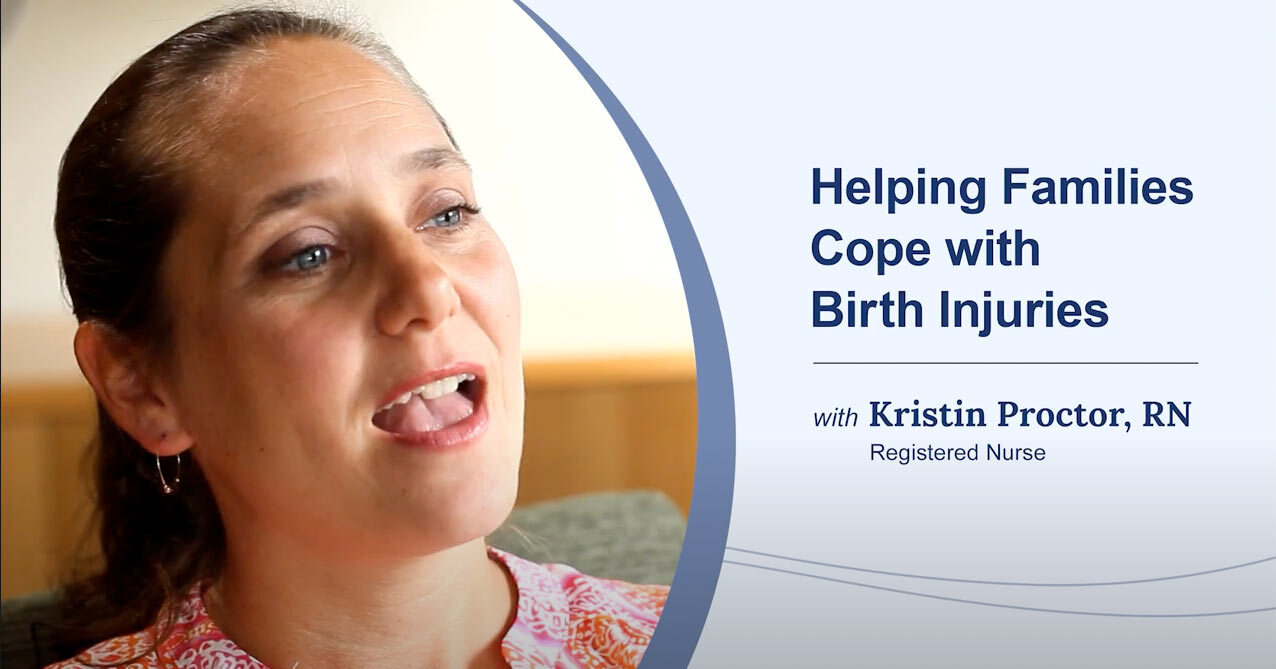What to know about different types of birth injuries
Welcoming a new baby should be a time of joy, but sometimes unexpected challenges like various types of birth injuries can arise during childbirth.
It's important to know about the different birth injury types to be better prepared. Birth injuries can range from minor, such as mild bruising, to more severe conditions, like cerebral palsy or Erb's palsy. Each of these conditions may occur due to complications during pregnancy, labor, or delivery.
Some injuries are temporary and heal quickly, while others might require long-term medical care. It's crucial to remember that these incidents are not always preventable and don't reflect on the care or love you provide.
If your child was affected by a birth injury, know that support and resources are available to help you and your family navigate this journey with compassion and strength.
Watch our short video to learn how our caring team of nurses and patient advocates can support your family.
One of our nurses, Kristin Proctor, explains how she supports, educates, and advocates for our birth injury clients. View Transcript.
Duration: 1 min 56 sec
I think my work helps people because sometimes a mother who's been through these traumatic situations just needs somebody to listen to them and to hear their story and to validate their feelings. And I have the opportunity to do that. Even if we can't help them with a claim, we do have the opportunity to hear them out and validate their feelings. One of the first big claims I ever helped with was a little boy who was full term and the parents were expecting a healthy baby. Everything had gone smoothly. Then the labor and delivery was very complicated and there were some issues with the baby being in distress and an untimely delivery. It took a little bit too long for the doctors to make the decision and for the baby to be delivered. And unfortunately, the child suffered from cerebral palsy with lifelong complications.
The family needed a whole new home and lots of modifications to their lifestyle to adapt for this child. And speaking to the mother, it was very touching. It was life changing hearing her story and what she had to go through and how now the rest of this child's life will be complicated by cerebral palsy. We were able to help that family with a significant settlement. I believe it was around four or five million dollars to help them restructure their home and provide the therapies that this child would need for the rest of his life. We also provide clients with resources. We have a cerebral palsy guide, which can help different parents who have children, or if you have a grandchild or a family member, a friend who might have cerebral palsy, we do have a guide that can help provide some resources. We also would be happy to speak with anybody about the situation that they're going through and the injuries their child has gone through.
Types of birth injuries: Early signs of harm in newborns
Recognizing early signs of harm in newborns is essential for getting prompt medical attention and proper care for your child.
- Abnormal appearance: Look for any unusual physical features or signs of distress, such as bluish or pale skin tone
- Developmental delays: Watch for any milestones your child does not reach on time
- Difficulty breathing: Newborns may struggle to breathe if they've experienced a birth injury
- Excessive crying: Persistent crying could indicate discomfort or pain due to an injury
- Feeding problems: Difficulty with nursing or bottle-feeding can be a sign of injury
- Limited movement: Several types of birth injuries may restrict a newborn's ability to move certain body parts
If you notice any of these signs in your newborn, seek medical attention. An accurate diagnosis and early intervention can significantly improve your child's long-term well-being.
Cerebral Palsy Guide has a supportive team of labor and delivery nurses on staff who are here to help answer your questions. If you're concerned that your child might have a birth injury, they're ready to listen and discuss your situation confidentially.
Connect with a registered nurse now.
What are the most common types of birth injuries?
There are several types of birth injuries. Learn more about common birth injury types below.
- Brachial plexus injury and Erb’s palsy
- Brain damage
- Cephalohematoma (skull bleeding)
- Cerebral palsy
- Forceps delivery complications
- Hydrocephalus
- Hypoxic-ischemic encephalopathy (HIE)
- Infant meningitis
- Kernicterus
- Meconium aspiration syndrome (MAS)
- Periventricular leukomalacia (PVL)
- Shoulder dystocia
- Spinal cord injuries
- Stillbirth (intrauterine fetal demise)
- Vacuum extractor complications
- Other types of birth injuries
Erb’s palsy and other brachial plexus injuries affect the nerves that control the muscle function of the hands, arms, and shoulders.
These injuries often happen due to shoulder dystocia, which is when the baby’s head delivers, but the shoulders are stuck in the birth canal.
Common symptoms of brachial plexus injuries and Erb’s palsy include:
- Lack of muscle control in the elbow, wrist, or hand
- Less sensation in the affected limb(s)
- Paralysis or weakness of the affected limb(s)
Brain damage or brain trauma is often the result of intracranial hemorrhage (bleeding around or in the brain), oxygen deprivation, blood clots, and other complications.
Symptoms of brain injury include:
- Abnormal vital signs, including low blood pressure and low oxygen levels
- Decreased or lack of standard newborn reflexes
- Difficulty swallowing or eating
- Lacerations on the baby’s scalp
- Muscle tremors
- Seizures
Cerebral palsy (CP) is a group of neurological disorders typically caused by brain damage. The condition affects muscle control and tone and can lead to problems with movement, posture, and balance.
The five main types of cerebral palsy are spastic, ataxic, athetoid (dyskinetic), hypotonic, and mixed type.
While symptoms of CP can vary by type, they often include:
- Delayed speech or growth development
- Impaired fine motor skills, such as picking up objects
- Neurological complications, such as abnormal eye movements
- Spasticity or prolonged muscle tightness
Forceps delivery complications may happen when medical providers apply too much force onto a baby’s head when using forceps to assist with delivery.
Injury from forceps delivery include:
- Intracranial hemorrhage, a severe condition where bleeding occurs inside the skull
- Nerve damage causing temporary facial nerve palsy (drooping or weakness) that heals within a few weeks
- Severe brain injury leading to long-term neurological complications or developmental delays
- Skull fractures that heal on their own and don’t cause long-term damage
- Surface wounds to the face or head that heal in a few days
Hydrocephalus is a neurological disorder caused by a buildup of cerebrospinal fluid in the cavities within the brain. This extra fluid puts pressure on the brain by causing its cavities to widen.
Symptoms of hydrocephalus in infants include:
- Eyes that are fixed downward
- Head size that is larger than average
- Problems feeding or sucking
- Seizures
- Sleepiness
- Vomiting
Hypoxic-ischemic encephalopathy (HIE) is one of the more severe types of brain injuries. HIE happens when a baby’s brain doesn’t get enough oxygen or blood for a period of time during labor or delivery.
It can be the result of newborn infections, heart disease, lung malformations, severe fetal anemia (low amount of blood cells that carry oxygen to the body), placental issues, and other problems.
Symptoms of HIE depend on the extent and severity but may include:
- Abnormal seizures or movements
- Kidney, lung, heart, blood, and liver dysfunction
- No reaction to sounds or sights
- Weak cry
Infant meningitis is an inflammation of the membranes that cover the spinal cord and brain (meninges). It is caused by viruses and bacteria, and infants are more susceptible to this if they have had brain surgery or a skull fracture. Vaccinations in the mother can help prevent infant meningitis.
Signs and symptoms of infant meningitis include:
- Drowsiness and lack of energy
- Fever
- Headache
- Irritability
- Poor appetite
- Stiff neck
Newborn kernicterus, also known as bilirubin encephalopathy, results from high levels of bilirubin (yellow pigment from red blood cell breakdown). It can cause brain damage, hearing loss, cerebral palsy, and cognitive problems.
Kernicterus often results from untreated jaundice, which causes a yellow tone in the skin, mucous membranes of the mouth, and the white part of the eyes.
Symptoms of newborn kernicterus include:
- Decreased or absent reflexes
- Fever
- Floppy muscle tone
- Irritability with a high-pitched cry
- Lack of energy
- Vomiting
Meconium is a baby's first stool or feces. If a newborn passes meconium before they are born, they can breathe in a mix of amniotic fluid and meconium into the lungs around delivery time. This can cause meconium aspiration syndrome (MAS) to occur. MAS can lead to long-term harm and even death.
Symptoms of meconium aspiration syndrome include:
- Bluish skin color
- Breathing problems
- Dark streaks or other signs of meconium in the amniotic fluid
- Limp muscle tone
Newborn cephalohematoma or skull bleeding is when blood collects between a newborn’s skull or scalp. It happens when pressure is put on an infant’s head, breaking blood vessels in the scalp.
Complications and symptoms of cephalohematoma may include:
- Anemia (low red blood cell count)
- Calcifications (hardened bone deposits) around the cephalohematoma mass
- Infections
- Reddened blood-filled bulge on the back of the skull, usually more on one side
- Skull fractures
Periventricular leukomalacia (PVL) is a neurological condition mainly affecting infants, especially those born prematurely.
PVL involves damage to the brain's white matter, the area near the brain’s ventricles (cavities). This happens when there's inadequate blood flow or oxygen to the brain tissue. PVL is considered one of the more serious birth injury types when it results in significant brain damage.
Symptoms of PVL vary but may include:
- Coordination challenges
- Developmental delays
- Muscle stiffness
- Problems with motor skills
In some cases, PVL can lead to more serious types of birth injuries like cerebral palsy.
Shoulder dystocia occurs when one or both of an infant’s shoulders or arms get stuck during vaginal birth after the head is delivered.
It can result in physical injuries, such as a broken clavicle (collarbone) or oxygen deprivation. When shoulder dystocia occurs, it cuts off the infant’s oxygen supply. It is a life-threatening emergency for the infant. It is also one of the more common causes of Erb’s palsy.
Shoulder dystocia is more likely to occur in the following situations:
- Baby is positioned incorrectly for birth, such as in the breech position (feet or buttocks first)
- Birth weight exceeds 8 pounds and 13 ounces (fetal macrosomia)
- Limited pelvic space due to the birthing position
- Mother's pelvic opening is smaller than the baby's size
Newborn spinal cord injuries are rare but serious conditions that can occur during childbirth. These types of birth injuries can result from excessive pulling or twisting, especially in difficult deliveries.
The consequences can range from mild, temporary issues to more severe, long-term disabilities. Early detection and treatment of these birth injury types are crucial for the best outcomes.
Signs and symptoms of spinal cord injuries include:
- Breathing difficulties if the injury is high in the spinal cord
- Muscle stiffness or spastic movements
- Noticeable pain or discomfort when moving the baby's spine or limbs
- Poor feeding due to weakness or coordination problems
- Weakness or paralysis in arms or legs
Stillbirth or intrauterine fetal demise (IUFD) is when a baby dies in the womb at or after the 20th week of pregnancy.
IUFD can be caused by genetic disease, infection, pregnancy complications, problems with the umbilical cord or placenta, and other issues.
The following risk factors can affect the likelihood of experiencing a stillbirth:
- Previous pregnancy complications: Those who have had a stillbirth before are at an increased risk of experiencing another.
- Stress: Significant stressors, like relationship or financial troubles, may elevate the risk of stillbirth.
- Substance use: Using alcohol, smoking, or recreational drugs can increase the chance of stillbirth.
- Type of pregnancy: Pregnancies involving multiples (twins or triplets, for example) carry a higher risk of stillbirth.
Vacuum extraction complications happen when delivery teams fail to use extractors properly during vaginal delivery.
Complications from vacuum extractors include:
- Cephalohematomas
- Facial nerve injuries and palsies
- Retinal (eye) hemorrhage
- Scalp lacerations
In addition to the more common types of birth injuries already mentioned, there are several other forms of birth trauma that can affect delicate newborns.
These other birth injury types may occur during childbirth:
- Caput succedaneum: Fluid buildup or swelling on the scalp
- Cervical dystonia: Contraction of neck muscles causing involuntary turning of the head
- C-section injuries: Harm caused during cesarean deliveries
- Facial paralysis: Loss of facial muscle movement
- Hematoma: Blood accumulation in a tissue
- Infant torticollis: Twisted neck
- Intraventricular hemorrhage: Blood accumulation in the brain
- Klumpke’s palsy: Nerve damage that affects the muscles of the arm
- Subconjunctival hemorrhage: Blood accumulation in the eye
If your child was harmed during childbirth, you probably wonder what happened or what you could have done differently.
Knowing what caused your child harm is often the first step in seeking closure, understanding potential medical needs, and exploring options for support and justice.
Types of birth injuries and their causes
The different birth injury types can result from many factors during the labor and delivery process. Common causes of birth injuries include unavoidable fetal and maternal health issues, as well as congenital birth defects.
While many birth injuries can’t be prevented, medical negligence may be responsible for some cases. Medical malpractice is when obstetricians, doctors, and other medical professionals fail to uphold the standard of care during pregnancy and childbirth.
- C-section delays: Failing to perform a timely cesarean section when necessary
- Assisted delivery tool misuse: Improper use of forceps or vacuum extraction during delivery
- Failure to detect and treat fetal distress: Not recognizing and treating dangerous heart rate changes or lack of oxygen
- Medication errors: Prescribing incorrect medications or doses during labor or delivery
- Neglecting umbilical cord complications: Failing to address issues with the umbilical cord, such as prolapse (cord falling down through vaginal area) or entanglement
- Poor prenatal care: Inadequate management of maternal and fetal health before delivery
If your child was harmed at birth, you may be able to take legal action to access the money you need to provide a secure future for your family.
Cerebral Palsy Guide partners with top birth injury attorneys. As of 2024, they have helped recover over $862 million for families in all 50 states.
Find out if we can help you right now with a free legal case review.
Treatment options for different types of birth injuries
Effectively managing various types of birth injuries involves understanding the available treatment options. The appropriate treatment can significantly impact your child's long-term well-being.
- Braces or orthotic devices: Used to support and improve mobility in cases of limb injuries
- Medications: Prescribed to manage pain, inflammation, or other medical conditions resulting from birth injuries
- Physical therapy: Helps improve muscle strength, coordination, and overall mobility
- Speech therapy: Assists with speech and language development in cases of birth-related speech issues
- Surgery: May be necessary for repairing certain birth injuries, such as nerve damage or fractures
- Vision therapy: Aids in addressing visual problems caused by birth injuries
Talk with your child’s doctor to determine the most suitable treatment plan. Early intervention and a personalized approach can contribute to better outcomes in many types of birth injuries.
Find help for a birth injury
Unfortunately, many types of birth injuries are the result of medical errors or negligence during childbirth. These avoidable injuries can have a profound and lasting impact on a child's life, especially in severe cases.
Working with an experienced birth injury attorney can help families get the financial aid they need to provide the best possible future for their child.
With the help of skilled legal professionals, many families have proven that their child's birth injury was caused by medical malpractice, securing financial compensation to ease the lifelong burden of medical expenses.
If you suspect your child's birth injury was due to health care negligence, your family may have legal options.
Reach out to Cerebral Palsy Guide right now at (855) 220-1101 or fill out this form for a free case review.





